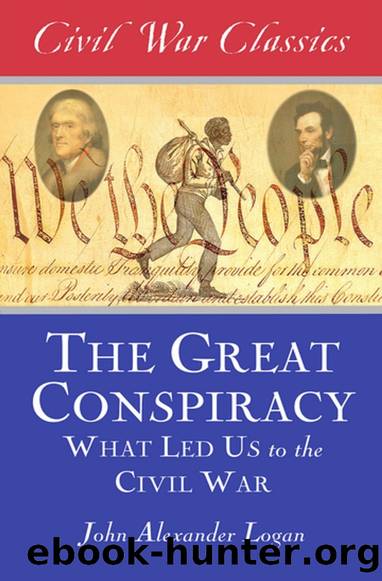The Great Conspiracy: What Led Us to the Civil War by John Alexander Logan

Author:John Alexander Logan [Logan, John Alexander]
Language: eng
Format: epub
ISBN: 9788027333691
Barnesnoble:
Published: 0101-01-01T00:00:00+00:00
The Great Conspiracy
Bridge,âand who says: âBefore reaching the point we designed to occupy (near the Stone Bridge) we were met by another order to march immediately to Manassas Junction, as an attack was apprehended that night.
Although it was now after sunset, and my men had had no food all day, when the command to march to Manassas was given, they cheerfully took the route to that place.â
Colonel Davies, who, as we have seen, commanded McDowellâs stubborn Left Wing, was after all, not far wrong, when, in his testimony before the Committee on the Conduct of the War, he declared, touching the story of the Bull Run Battle: âIt ought to have read that we were victorious with the 13,000 troops of the Left Wing, and defeated in the 18,000 of the Right Wing. That is all that Bull Run amounts to.â
In point of fact, the Battle of Bull Runâthe first pitched battle of the Warâwas a drawn battle.
War was now fully inauguratedâCivil Warâa stupendous War between two great Sections of one common Country; those of our People, on the one side, fighting for the dissolution of the Unionâand incidentally for Free Trade, and for Slavery; those on the other side, fighting for the preservation of the Unionâand incidentally for Protection to our Free Industries, and for the Freedom of the Slave.
As soon as the Republican Party controlled both Houses of Congress it provided Protection to our Free Industries, and to the Free Labor engaged in them, by the Morill Tariff Act of 1860âthe foundation Act of all subsequent enactments on the subject. In subsequent pages of this work we shall see how the Freedom of the Slave was also accomplished by the same great Party.
CHAPTER XIV. THE COLORED CONTRABAND.
When the first gun was fired at Fort Sumter, its sullen echoes sounded the funeral knell of Slavery. Years before, it had been foretold, and now it was to happen. Years before, it bad been declared, by competent authority, that among the implications of the Constitution was that of the power of the General Government to Emancipate the Slaves, as a War measure. Hence, in thus commencing the War of the Rebellion, the South marched with open eyes upon this, as among other of the legitimate and logical results of such a War.
Patrick Henry, in opposing the ratification by Virginia of the Federal Constitution, had declared to the Slaveholders of that State that âAmong ten thousand implied powersâ which Congress may assume, âthey may, if we be engaged in War, liberate every one of your Slaves, if they please, * * * Have they not power to provide for the General Defense and Welfare? May they not think that these call for the abolition of Slavery?
May they not pronounce all Slaves Free? and will they not be warranted by that power? * * * They have the power, in clear, unequivocal terms, and will clearly and certainly exercise it.â
So, too, in his great speech of May 25, 1836, in the House of
Download
This site does not store any files on its server. We only index and link to content provided by other sites. Please contact the content providers to delete copyright contents if any and email us, we'll remove relevant links or contents immediately.
| United States | Abolition |
| Campaigns & Battlefields | Confederacy |
| Naval Operations | Regimental Histories |
| Women |
In Cold Blood by Truman Capote(3346)
The Innovators: How a Group of Hackers, Geniuses, and Geeks Created the Digital Revolution by Walter Isaacson(2997)
Steve Jobs by Walter Isaacson(2858)
All the President's Men by Carl Bernstein & Bob Woodward(2346)
Lonely Planet New York City by Lonely Planet(2196)
And the Band Played On by Randy Shilts(2166)
The Room Where It Happened by John Bolton;(2133)
The Poisoner's Handbook by Deborah Blum(2111)
The Murder of Marilyn Monroe by Jay Margolis(2079)
The Innovators by Walter Isaacson(2075)
Lincoln by David Herbert Donald(1965)
A Colony in a Nation by Chris Hayes(1901)
Being George Washington by Beck Glenn(1778)
Under the Banner of Heaven: A Story of Violent Faith by Jon Krakauer(1765)
Amelia Earhart by Doris L. Rich(1669)
The Unsettlers by Mark Sundeen(1658)
Dirt by Bill Buford(1650)
Birdmen by Lawrence Goldstone(1639)
Zeitoun by Dave Eggers(1618)
